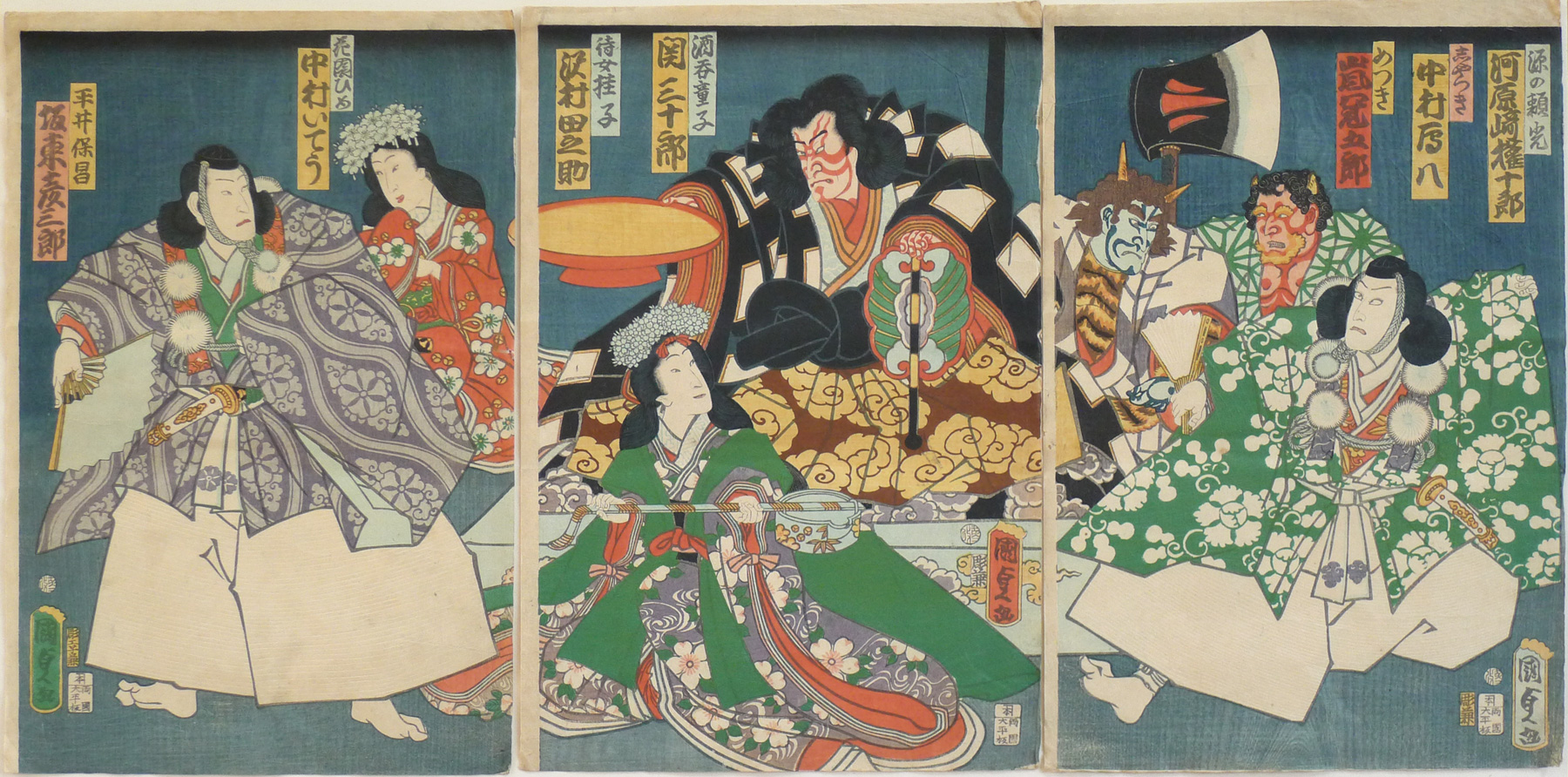About This Print
This print shows the actors (from right to left) Kawarazaki Gonjūrō as Minamoto no Yorimitsu, Nakamura Ganpachi as the demon Shiyatsuki?, Arashi Kangorō as the demon Metsuki?, Seki Sanjūrō III as Shuten Dōji, Sawamura Tanosuke III as Jijo (lady attendant) Keiko?, Nakamura Ichō as Hanazono Hime and Bandō Hikosaburō V as Hirai no Yasumasa (a retainer of Minamoto no Yorimitsu) in the play A Modern Shuten Dōji (Imayō Shuten Dōji), performed at the Nakamura-za in February 1863.Shuten Doji - A Popular Kabuki Theme
Source: website of The British Museum http://www.britishmuseum.org/research/collection_online/collection_object_details.aspx?objectId=790133&partId=1&matcult=16006&sortBy=imageName&page=1
"One of Japan's most popular stories was the legend of the destruction by Minamoto no Yorimitsu (who actually lived AD 948-1021) of the ogre called the Shuten Doji ('The Drunken Boy'). This flesh-eating, drunken giant lived in the mountains, where he kept young women captive, some of whom he ate. Yorimitsu and his four companions gained access to his lair disguised as travelling priests, got the monster intoxicated, and cut off his head. The real Yorimitsu was a warrior who helped the court rid Japan of bandits and pirates, hence the attachment of this legend to him."
Source: "Writing the Love of Boys: Representations of Male-Male Desire in the Litereature of Murayama Kaita and Edogawa Ranpo," a dissertation by Jeffrey M. Angles, Ohio State University, 2003
"The Shuten dōji story was the subject of a large number of kabuki plays, including Shuten dōji (first performed in 1638), Imayō shuten dōji (A Modern Day Shuten Dōji, 1681), Shuten dōji oni taiji (The Subjugation of the Demon Shuten Dōji, 1684), Ōeyama no oni taiji (The Subjugation of the Demons of Mount Ōe, 1684), Shuten dōji furiwakegami (Parted Hair of Shuten Dōji, 1733), Ōeyama (Mount Ōe, 1861), Ōeyama shuten dōji (1867), and Ōeyama Minamoto no Tuwamono (Ōeyama and the Courageous Minamoto Warriors, 1887)."
"The Shuten dōji story was the subject of a large number of kabuki plays, including Shuten dōji (first performed in 1638), Imayō shuten dōji (A Modern Day Shuten Dōji, 1681), Shuten dōji oni taiji (The Subjugation of the Demon Shuten Dōji, 1684), Ōeyama no oni taiji (The Subjugation of the Demons of Mount Ōe, 1684), Shuten dōji furiwakegami (Parted Hair of Shuten Dōji, 1733), Ōeyama (Mount Ōe, 1861), Ōeyama shuten dōji (1867), and Ōeyama Minamoto no Tuwamono (Ōeyama and the Courageous Minamoto Warriors, 1887)."
The Actors in the Print
For background on the actors Kawarazaki Gonjūrō, Nakamura Ganpachi, Arashi Kangorō, Seki Sanjūrō III, Sawamura Tanosuke III, Nakamura Ichō and Bandō Hikosaburō V see their respective entries in the article The Kabuki Actor on this site.Print Details
| IHL Catalog | #1652 |
| Title | Kawarazaki Gonjūrō, Nakamura Ganpachi, Arashi Kangorō, Seki Sanjūrō III, Sawamura Tanosuke III, Nakamura Ichō and Bandō Hikosaburō V [in the play Imayō Shuten Dōji] 河原崎権十郎, 中村鴈八, 嵐冠五郎, [3]関三十郎, [3]沢村田之助, 中村いてう, [5]坂東彦三郎, 當世酒呑童子 |
| Series | n/a |
| Artist | Utagawa Kunisada II (1823-1880) |
| Signature |  |
| Seal | Toshidama 年玉枠 (see Signature above) |
| Publication Date |  |
| Publisher |  Daikokuya Heikichi (firm name Shōjudō) on each sheet [Marks: seal 22-094; pub. ref. 029] |
| Carver |   seal on right appearing on left sheet reading: 彫工子兼 Horikō Ko-Kane |
| Impression | excellent |
| Colors | excellent |
| Condition | good - |
| Genre | ukiyo-e; yakusha-e |
| Miscellaneous | |
| Format | vertical ōban triptych |
| H x W Paper | right sheet: 14 1/2 x 9 7/8 (36.8 x 25.1 cm) center sheet: 14 1/2 x 9 7/8 (36.8 x 25.1 cm) left sheet: 14 9/16 x 9 7/8 (37 x 25.1 cm) |
| H x W Image | right sheet: 14 1/8 x 9 5/8 (35.9 x 24.4 cm) center sheet: 14 1/4 x 9 1/2 (36.2 x 24.1 cm) left sheet: 14 3/16 x 9 5/8 (36 x 24.4 cm) |
| Collections This Print | The Tsubouchi Memorial Theatre Museum of Waseda University 101-7276, 101-7277, 101-7278 |
| Reference Literature | |


